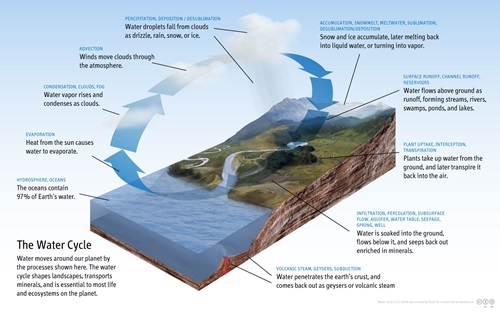The Water Cycle
Understanding water begins at the highest level with understanding the water cycle, or hydrological cycle. It describes the continuous movement of water in its various states (liquid, solid, vapor) on, above, and below the surface of the Earth. During every step of its epic travels, our planet’s water cycle provides the very essentials of life.
The quantity of water on our planet remains constant, but its rate of movement and distribution varies drastically. For instance, water evaporating from oceans can return to the ocean in the form of rain in a matter of days. But if that water were to fall on land or on ice caps as snow, it could take thousands of years to make its way back to the ocean through underground aquifers or melting glaciers.

click to enlarge
Source – Wikipedia
We often naively think the Earth has an abundance of water, and that we’ll never run out. But 97% of the Earth’s water is held in saltwater oceans, with less than 1% available for human use – in freshwater lakes, rivers, and groundwater sources. Increasingly, human activities are rendering some of these sources unusable due to critical depletion, salinification, and pollution. And now climate change is one more factor affecting the supply of water we depend on.
Climate Change and Water
The water cycle and climate are inextricably linked. Temperature changes alone directly impact rates of water evaporation and precipitation – something we’ve all witnessed as hotter summers lead to droughts and wildfires. But a changing climate not only affects how much rain or snow we receive, but where it falls. We’re already seeing changes in precipitation patterns in the U.S., with many areas getting more rain and snow than normal, while others such as the Southwest receiving considerably less.
The illustration below shows how precipitation is changing in the U.S. compared to 1901-1960 averages. The colors on the map show annual total precipitation change from 1991-2012, and the bar graphs show change by decade for 1901-2012. The last bar in each graph is for 2001-2012.
Observed US Precipitation Change

click to enlarge
Source – U.S. National Climate Assessment
While we might look at the above map and think most of the country is doing “OK” and receiving more yearly precipitation than average, much of this is coming over shorter periods, so even these “wetter” areas can experience short term drought, such as in summer months. And when precipitation does come, it can be in the form of more intense storms that cause flooding. Flooding may replenish some freshwater sources, such as lakes and reservoirs, but it can also contaminate them with washout sediments and manmade pollutants.
Fresh Water Supply and Demand
We know fresh water supply has been decreasing in many areas of the country, and that’s being accentuated by increasing demand. The U.S.’s growing and shifting population is the key driver of this increased demand. More people naturally equals more water use, with many of them preferring to live in warmer, sunnier climates – areas of the country already experiencing water supply issues.
The maps below show projected demand for water from 2005 to 2060, with and without climate change being factored in with changes in population and socioeconomic conditions.
Projected Changes in Water Withdrawals

click to enlarge
Source – U.S. National Climate Assessment
Dealing with population growth and distribution may seem simple when compared to dealing with the ways we use (and waste) water. The decisions to put in a pool, build golf courses in the desert, or increase our consumption of water-intensive foods, are socioeconomic ones we make as individuals and as a society. These are tough decision that will require major changes in attitudes and action at every level.
Water Stress
Increasing demand for fresh water supply pitted against decreasing supply is leading to something we call “water stress”. We say a watershed is stressed when demand continually exceeds available supply – a situation that is already occurring in many parts of the country. A Harvard University study projects that by 2071, nearly half of the 204 fresh water basins in the U.S. may be critically stressed and not able to meet monthly demand.
Water Stress in the US

click to enlarge
Source – U.S. National Climate Assessment
But What Can I Do?
When faced with problems as monumental as the environment and climate change our impulse can be to deny, ignore, or simply throw up our hands in defeat. While this may help us get through the day, it does no service to future generations. And the tragedy in this thinking is that when it comes to water use, positive changes are relatively easy to make, with little negative impact on our quality of life.
"The greatest danger to our future is apathy.” — Jane Goodall
On an individual level, alleviating water stress means being aware of your water use habits and eliminating waste. That’s everything from taking shorter showers, to planting lawns and gardens so they use less water. It also means regularly checking for leaks in your home's plumbing. These tasks can be made easier by using the consumption information from your utility bill or My Utility Account to help you conserve water.
And on a larger scale, it means knowing where your community’s water comes from and how we treat it to ensure its quality, all of which you can learn about in your yearly Water Quality Reports. It also means being aware of and involved in local water issues and making sure your elected representatives share your concerns.
More Information
There’s plenty of information online to help you learn about water, the environment, and climate change. Wikipedia is a good place to start for general information, and these sites can provide information more specific to the U.S.